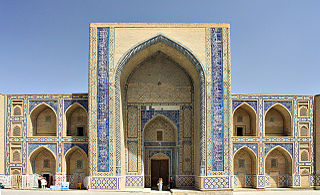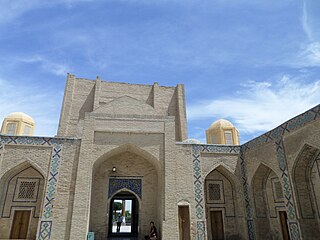
Bukhara Region is a region of Uzbekistan located in the southwest of the country. The Kyzyl Kum desert takes up a large portion of its territory. It borders Turkmenistan, Navoiy Region, Qashqadaryo Region, a small part of the Xorazm Region, and the Karakalpakstan Republic. It covers an area of 40,216 km2. The population is estimated at 1,976,823, with 63% living in rural areas.

Nodir Devonbegi is a historical memorial in Bukhara, Uzbekistan. It was established by Nodir Devonbegi, the vizier and brother of the ruler of Bukhara, Imamquli Khan, in 1620–1621. The Khanaka has been included in the national list of intangible cultural heritage objects of Uzbekistan.
Askarbiy madrasah is located in Bukhara. The madrasa has not been preserved today. The Askarbiy madrasa was founded by Muhammad Askarbiy under the leadership of Qambari father. Qambari's paternal guzar was later called Askarbiy. In the sources, this guzar is mentioned as Askarbiy guzar. Research scientist Abdusattor Jumanazarov studied a number of foundation documents related to this madrasa and provided information related to the madrasa. According to the foundation document, Muhammad Askarbiy Qambari began to build a mosque and a madrasa under his father's guise. The madrasa was built with 12 rooms of baked bricks, and the mosque was built of wood. The northeastern side of the madrasa had a porch. To the west of the madrasa was the yard of Ismatullah ibn Hasan, to the north was the yard of Olimjan ibn Badaljan and Ustad Nazirjan ibn Badaljan, and to the south and east there was a public road. For this madrasa, Muhammad Askarbiy donated three parts of his property in Armitan region of Kokhkash, Poyirud, Shanba Kotarma region near Dabusiya castle, and one bakery in Bukhara region. The waqif itself was a benefactor to the madrasa. After his death, his descendants performed this task. The first document of this foundation was issued in 1791. This document was approved by Qazi ul-Quzzat Mir Muhammad Fuzayl ibn Mir Muhammad Amin Abdulbari Aziz. In the madrasa, the class was taught by the Banorasposh müderris. There are also many foundation documents about Askarbiy Madrasah, which also contain information about students. Sadri Zia wrote that there were 12 rooms in this madrasa. This madrasa was built in the style of Central Asian architecture.
Muhammad Nazar Parovanachi Madrasah is located in Bukhara. The madrasah has not been preserved today. The Madrasah of Muhammad Nazar the Propeller was built by Khoja Khizr, Muhammad Nazar the Propeller Ibn Ghayib Nazarbi. Research scientist Abdusattor Jumanazarov studied a number of foundation documents related to this madrasah and provided information related to the madrasah. In the endowment document, Hazrat Kalmoqjan Ayim binti Amir ul-Mahrum endows 12 pieces of land in the village of Koshki Safed, Sulakiyan, Arus in 1793 for this madrasah. To the west of Muhammad Nazar parovanachi madrasah there was Havzi lisak land, to the north and east Muhammad Nazarbi yard and street, to the south Guzar mosque and street. Five more foundation documents related to the activities of the madrasah have been preserved. In one of the documents of the foundation, it is mentioned that the madrasa mudarris Alakhoja was a judge of the Samjan district and another mudarris was appointed in his place. At that time, the salary of Mir Rahmatullah and Mullah Alakhoja, the head of the Madrasah of Muhammad Nazar, was 55 gil. A number of waqf documents contain information about mudarris and their salaries. In particular, Mullah Ibrahim's salary was 50 gold, Mullah Abdurahim's salary was 40 gold, and Mullah Abdujalil's salary was 45 gold. This madrasah was demolished during the revolution. Sadri Zia wrote that there were 13 rooms in this madrasah. Muhammad Nazar parvanachi madrasah consisted of 13 rooms. This madrasah was built in the style of Central Asian architecture. The madrasah is built of brick, wood, stone and ganch.
The Ikromkhoja Madrasa was a madrasa in Bukhara Region. The madrasa no longer exists today.
The Ahmadjon Postindoz Madrasa was a madrasa located in Bukhara Region. It no longer exists today. Ahmadjon Postindoz Madrasa was built in the Asiriy neighborhood, during the reign of Amir Nasrulloxon (1826-1860) of the Emirate of Bukhara, by Domulla Ahmadjon, son of mulla Avazjon. This madrasa was built in 1705. The scholar Abdusattor Jumanazarov studied a number of endowment documents related to this madrasa and provided information about it. In front of this madrasa, Domulla Ahmadjon also built a school of baked brick, wood and plaster. Domulla Ahmadjon endowed 363 plots of land in the north river district of Bukhara, a bathhouse in Chorbogi Oliya, and three shops in the Asiriy neighborhood, to ensure the functioning of the madrasa and the school. In this madrasa, every Friday, the imam and the school teacher recited the "Ikhlas" sura three times and dedicated the reward to the founder’s soul. Ahmadjon Postindoz Madrasa housed two students in each room. The endowment property was not rented out to tenants for more than three years. Many teachers taught at Ahmadjon Postindoz Madrasa. According to other endowment documents, 306 plots of land were endowed for this madrasa by Ahmadjon, son of Avazbadal, in 1858-1858. Information about the students and teachers who studied at this madrasa has also been preserved. Sadri Ziyo wrote that Ahmadjon Postindoz Madrasa had ten rooms. Ahmadjon Postindoz Madrasa consisted of nine rooms and one classroom, a winter mosque and a summer veranda. The madrasa was made of baked brick, wood, stone and plaster.
The Chuchuk Oyim Sangin Madrasa was a madrasa located in Bukhara Region. It no longer exists today.
Domulla Sher Madrasah is located in Bukhara. The Madrasah has not been preserved today. Domulla Sher Madrasah was built by Domulla Shermuhammad in the 19th century under Khoja Zomuchi, during the reign of Amir Haydar, who ruled the Bukhara Emirate. Research scientist Abdusattor Jumanazarov, studied a number of foundation documents related to this Madrasah and provided information related to the Madrasah. According to the foundation documents, the Madrasah consisted of 15 upper and lower rooms, a classroom, a mosque, a toilet and a mustahabkhana. There was a Kokaldosh Madrasah and a street in the west of the Madrasah, a street and a courtyard in the north and east, and a courtyard of Muhammad Salim in the south and a road leading to the Kokaldosh Madrasah. This Madrasah was supported by the foundation itself. At the end of the 19th century, Mullah Nabirahoja taught in the Madrasah. During the Soviet period, in 1922, the Domulla Sher Madrasah was turned into a prison. Domulla Shermuhammad was one of the prominent scholars of his time. He reached the level of recitation and taught at the Kokaldosh madrasa. He is originally from Kogan and lived in Bukhara for many years. He received his knowledge from Shaykhul-Islam Atoullah Khoja ibn Hadikhoja. Domulla Shermuhammad became blind at the end of his life. He died in 1824 at the age of 86 Sadri Zia wrote that there were 49 rooms in this Madrasah. The research scientist Abdusattor Jumanazarov, based on the documents of the foundation, indicated that the Madrasah consists of 19 rooms. Domulla Sher Madrasah consisted of 19 rooms. This Madrasah was built in the style of Central Asian architecture. The Madrasah is built of brick, wood, stone and ganch.

A'lam madrasah is a two-story madrasah located in the historical center of the city of Bukhara, Bukhara Region, Republic of Uzbekistan. It is included in the national list of real estate objects of material and cultural heritage of Uzbekistan.
Khoja Nihol Madrasah was a historical monument built in Bukhara. The madrasah has not been preserved today.
Khalifa Khudoidod Madrasah is an architectural monument located in Bukhara. It is included in the national list of real estate objects of material and cultural heritage of Uzbekistan. Khalifa Khudoidod madrasah was built by Khalifa Khudoidod in 1796-1797, during the reign of Amir Shah Murad, who ruled the Emirate of Bukhara.
Boloyi hovuz Madrasah is located in Bukhara. Boloyi hovuz madrasah was built in the 18th century by Sitorai Mohi Hossa, the wife of Ashtarkhani ruler Subkhanqulikhan, who ruled the Bukhara Khanate, in the courtyard of the Shodimbi patriarchal mosque. Research scientist Abdusattor Jumanazarov studied a number of foundation documents related to this madrasah and provided information related to the madrasah. In the document, Madrasa Zaman Bilqisi will build a wooden and brick house, a jame mosque and nineteen rooms in the west of Registo in Bukhara, in the vicinity of the Shodimbi paternal mosque. To the west of the madrasah was the property of the foundation, to the north was a road, to the east was a pond, and to the south was the Shodimbi paternal madrasah. The princess built a madrasah here for the poor to get an education. To ensure the activities of the madrasah and the mosque, 1000 tanobs of Khoris land were endowed in Shorcha district of Khutfar district. Mutawwali was the foundation itself. The endowment funds were taken from tithes. A number of other foundation documents related to the Boloyi hovuz madrasah were found and studied. Madrasah is considered one of the higher educational institutions of the third level in the Bukhara educational system. In one of the historical documents, there is information that a mudarris named Mullah Ashur Muhammad, belonging to the Banorasp category, taught in the madrasah. Abdulkhoja Abdi wrote in his work that Mullah Dost, who created under the pseudonym "Nadir", taught students at Boloyi hovuz madrasah. Sadri Zia wrote that there were 22 cells in this madrasah. Boloyi pool madrasah consisted of 19 rooms. This madrasah was built in the style of Central Asian architecture. The madrasah is built of brick, wood, stone and ganch.

Chuqur madrasah is a one-story madrasa building located in the historical center of the city of Bukhara, Bukhara Region, Republic of Uzbekistan. It is included in the national list of real estate objects of material and cultural heritage of Uzbekistan.

Daniyol Atalik Madrasah is an architectural monument. The one-story madrasah was built in the 1770s under the patronage of the Uzbek ruler Muhammad Daniyolbi. In the sources, it is also called Qorikhana. Bahauddin Naqshband was the second madrasah built after Mazari Sharif Higher Madrasah.

Ibrahim Akhund madrasah is a two-story madrasah located in the historical center of Bukhara city, Bukhara region, Republic of Uzbekistan. It is included in the national list of real estate objects of material and cultural heritage of Uzbekistan. The Varakhsha Archaeological Museum is in the building.

Istehza madrasah is a two-story madrasah building located in the historical center of the city of Bukhara, Bukhara Region, Republic of Uzbekistan. The smallest madrasah in Central Asia. It is included in the national list of real estate objects of material and cultural heritage of Uzbekistan.
The Chor Baqqoli Madrasa was a madrasa in Bukhara, Uzbekistan.

Mulla Ernazarbek madrasah is located in Bukhara. The madrasah was built by the son of Mullah Ernazar Maqsud in 1794–1795, during the reign of Amir Shahmurad, in the guzar of Sheikh Shona. It is located next to the Kokaldosh madrasah.

Tursunjan madrasah is one of the Bukhara madrasas. A two-story madrasah building located in the historical center of the city of Bukhara, Bukhara Region, Republic of Uzbekistan. It is included in the national list of real estate objects of material and cultural heritage of Uzbekistan.

Ulugbek madrasah is an architectural monument (1417) in Bukhara, Uzbekistan. It is the oldest preserved madrasah in Central Asia. It is the oldest of the madrasahs built by Ulugbek. During the reign of Abdullah Khan II, major renovation works were carried out (1586).

















